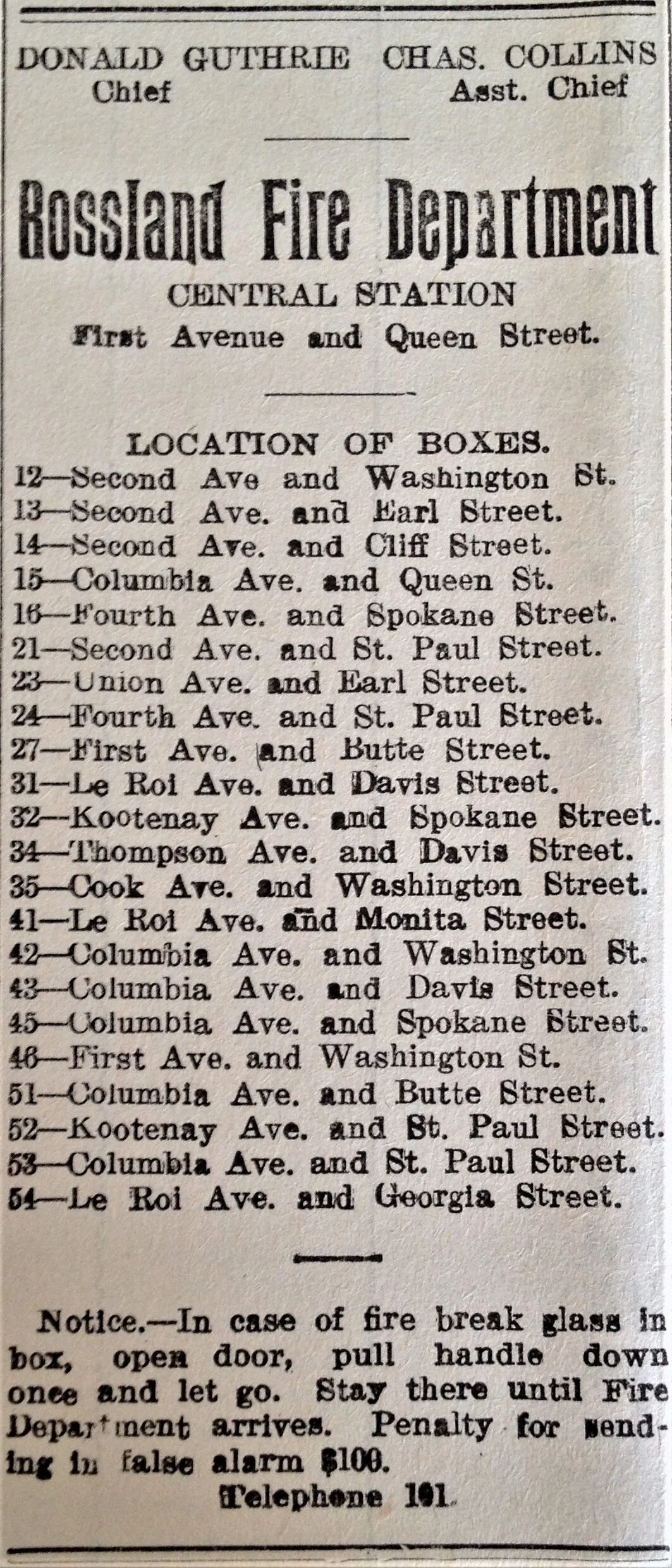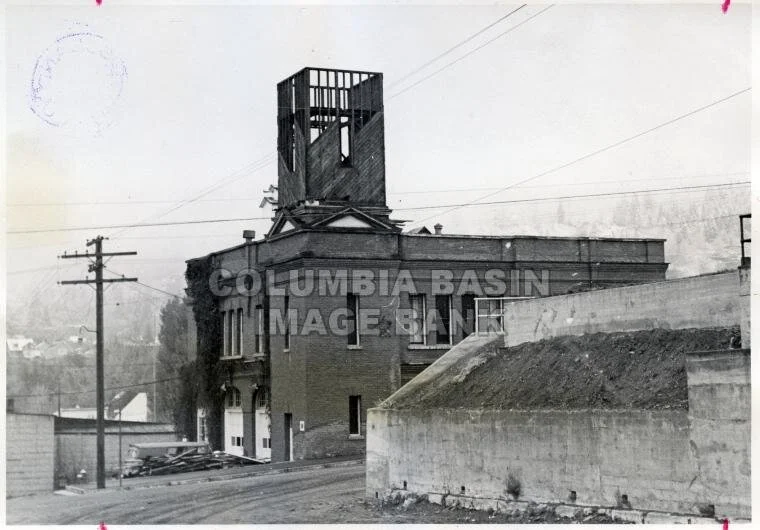British Columbia Firefighters’ Museum
In 1987, the dedicated firefighters of Rossland proposed the establishment of a Provincial Firefighters’ Museum right here in our historic Rossland Fire Hall/City Hall, located at 2115 Queen Street. A provincial firefighters’ museum, the only one in western Canada at the time, would be a valuable addition to Rossland’s roster of summer tourist attractions, but more importantly, the Rossland Firefighters had so many stories and a rich history of community firefighting to share.
Rossland’s Historic Fire Hall/City Hall
Fire Boxes advertisement from the Rossland Miner newspaper, 5 April 1902, page 4
The historic brick Rossland Fire Hall was constructed in 1901. In its early days, two paid firemen stayed in the hall while on shift and were supported by a group of volunteer firefighters. The City of Rossland made use of the second floor for its administrative offices and council chambers shortly after the building’s completion, sharing the building with the firemen for many years. The RCMP and Ambulance Services have also occupied parts of the building at various points in time.
Firefighters used hose carts pulled by horses until 1938. A heavy breed of draught horse was employed for the job, and when they were not out on the scene, they would be exercised by the young boys after school, never venturing too far away from the Fire Hall. Whenever the alarm bells sounded, the stalls at the back of the building would open, and the trained horses would move to the front of the fire sleigh/carriage for harnessing. The harness itself was suspended from the ceiling and could be dropped down and cinched in eight seconds!
When a fire was called, the fire bell would toll out a specific number of times to correspond with the number of the appropriate fire alarm box about town. There were around 50 fire alarm boxes, and the toll of the bell would signal where in town the fire was in relation to the nearest alarm box. For example, to signal a fire blazing near box 16, the bell would ring once, pause, then another six times. The bell is affectionately called Stella.
The bell was given to the Red Mountain Ski School in the 1960s, after the fire department had upgraded to a more sophisticated alarm system and no longer required the bell. It was returned to the Fire Hall in 1989, to be placed in the newly constructed bell tower. More than just a fire warning device, the historic bell had been an important time-telling object (as well as the mine whistle and the train). The fire bell rang every day at 7am, waking up citizens with seven tolls. It would then ring twelve times at noon, and again at 6pm, which was a signal for prostitutes to get to their evening work. Lastly, the bell sounded at 8pm as a curfew for children, which would be extended to 9pm during the lighter summer months. The bell no longer rests in the tower, which was not structurally sound enough to support it, but lives near the front of the building, safely enclosed in a display case.
The B.C. Provincial Firefighters’ Museum
The B.C. Provincial Firefighters’ Museum Society leased the building from the City of Rossland, a $1-a-year lease, for use of the building for the museum. Some of the first seed money for the B.C. Firefighters’ Museum was funded by Cominco firefighters, who contributed the money towards building renovations. Seed money was also raised by selling lapel pins, hats, and shirts, and by selling “brick shares,” which allowed people to buy a brick for the building for $5. The rest of the money came from grants, donations, fundraisers, and auctions. An architect and volunteer firefighter from Vancouver wished to play a part in the Hall’s restoration, and contributed renovation plans at no cost. A large amount of volunteer and community work contributed to the bulk of the labour and costs required for the restoration, as well as donations from all over the province. Government grants and funding from the British Columbia Heritage Trust also helped to restore the building as closely as possible to its original state. Today, a replica hose tower stands in for the original tower, which was torn down in 1961 after it was no longer needed. It had initially been used as a space for drying the fire hoses, which were made of canvas, to prevent rot and disintegration.
Commemorative bottle of wine to celebrate the opening of the museum on July 11th, 1992! Donated to the Museum in 2019.
The Museum officially opened on Saturday July 11, 1992 after 6 years of hard work restoring the facade and interior. The museum opening coincided with the ninth annual convention of the Volunteer Firefighters’ Association of B.C., hosted by Rossland. The larger firefighting artifacts, such as antique trucks, were housed downstairs, and the floor upstairs featured displays of the firemen’s dormitory, chief’s room, and alarm room. Fire departments across the province donated items for display, including the antique fire trucks that local children so enjoyed climbing upon and a coffee/tea/food cart from Vancouver, which was used to feed hungry, hard-working firefighters while fighting difficult blazes. Mounted on the wall was a trampoline used to safely deposit trapped citizens jumping from windows onto solid ground, which is still on display as of 2020 despite numerous tenant changes in in the main floor.
The date of the museum’s closure is still a puzzle, although it is widely agreed upon that the museum was only operational for a few years. Also unconfirmed is the exact reason why it closed! Low attendance rates and high operational costs may have contributed to the museum’s closure; the single sandwich board advertising the museum did little to draw in attendees, and the museum saw more local residents and schoolchildren than they did visitors from out-of-town. However, there were many positive thoughts from visiting volunteer firefighters and families interested in the art of firefighting, who were delighted with the wealth of information, stories, and objects on display.
Special thanks to Bill Profili, Vince Profili, Karen Thatcher, Lisa Henderson, and Greg Granstrom for sharing their recollections, and our 2019 RMDC Summer Students Grace Chen and Hannah Klemmensen for compiling this information.
More Information
Canadian Fire Fighters Museum - Canada’s Fire Fighting History






